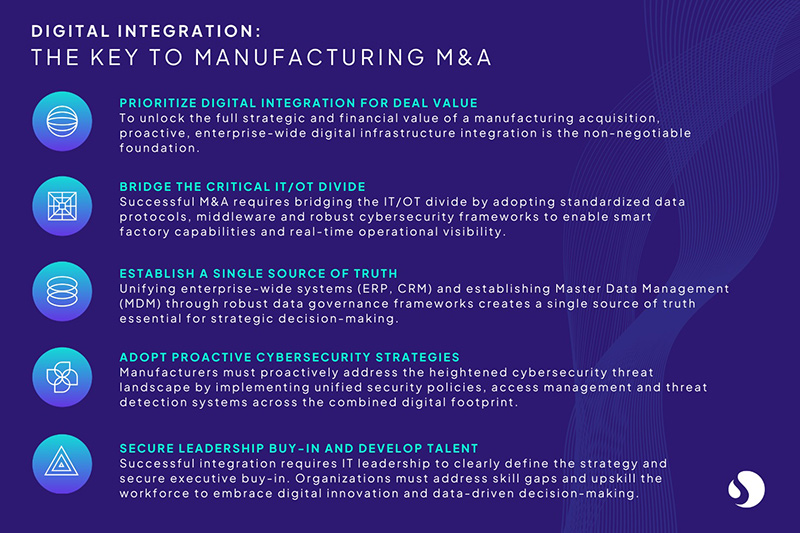Manufacturing M&A success requires prioritizing digital alignment to unify IT/OT, data, cybersecurity and secure executive buy-in.
By Liya Getachew, Principal, Sendero Consulting
Driven by market opportunities for growth, competitive advantage and operational synergies, manufacturing M&A activity is surging. The Industrials sector, for instance, had $169.5 billion in disclosed transaction value in Q3 of 2025, making it the second-highest sector, just behind Technology, Media & Telecommunications (TMT), for deal activity, fueled by automation, logistics consolidation and vertical integration. While financial synergies often dominate discussions, the true potential of these deals hinges on seamless digital integration. There are unique challenges for manufacturers when merging complex digital ecosystems, encompassing both Information Technology (IT) and Operational Technology (OT). To truly maximize deal value in manufacturing M&A, leaders must prioritize proactive digital infrastructure alignment, integrating IT and OT, unifying data, bolstering cybersecurity and building a future-ready digital foundation across the merged enterprise.
Disparate IT systems, data silos and unharmonized digital strategies create challenges for manufacturing operations post-merger. Inefficient workflows lead to production delays and operational redundancies, while data integrity issues compromise accuracy in inventory, supply chain and financial reporting. Instead of immediately realizing the promised synergies of scale and efficiency, companies may spend months, or even years, navigating manual processes, correcting data errors and dealing with internal conflicts caused by incompatible technology. When there is a major digital disconnect, the merger becomes an integration project, not a growth engine, inevitably resulting in delayed time-to-value.
Additionally, this can lead to increased cybersecurity vulnerabilities, compliance breaches and intellectual property (IP) exposure when merging unaligned digital assets. Ultimately, these disconnects directly erode deal value and severely hinder the realization of anticipated synergies, turning potential gains into avoidable losses.
One of the most common challenges in a manufacturing M&A involves integrating IT with OT, including Manufacturing Execution System (MES), Supervisory Control and Data Acquisition (SCDA), industrial control systems and robotics. Differences in lifecycles, protocols and security priorities exist in the IT and OT environments, so making their convergence seamless is vital for smart factory capabilities. If the two environments are siloed, the newly merged company will suffer through limited data visibility, lack of predictive maintenance and inefficient production planning.
To achieve successful IT/OT integration, the primary goal is to bridge the gap between IT’s quick refresh rate and OT’s long-term stability requirements. This is accomplished by adopting key strategies such as standardized data protocols, middleware solutions, cloud-based platforms and robust cybersecurity frameworks for industrial control systems. For example, implementing a MES acts as middleware, providing process harmonization by unifying how work orders, production flow and quality are tracked. Furthermore, utilizing Industrial Internet of Things (IIoT) platforms, which are systems of internet-connected devices, machines and applications used in industries to collect, monitor and analyze data, and cloud solutions ensures rapid scalability and advanced analytics across the merged enterprise.
A unified IT/OT landscape creates significant value by enabling improved real-time operational visibility, optimized production scheduling and enhanced quality control.

Unifying enterprise-wide IT systems including Enterprise Resource Planning (ERP), Customer Relationship Management (CRM), Product Lifecycle Management (PLM) and HR systems across the merged entities is essential. System consolidation involves the reduction of disparate IT systems into one platform, and examples of this include retiring redundant applications and application rationalization. Best practices for this include information migration, data merger and consolidation and robust governance frameworks to establish a single source of truth for all enterprise data. Examples include data quality assessment and cleansing and data mapping, both of which aid in the seamless process of moving from legacy systems of the acquired companies into a unified system. Robust data governance frameworks are the foundation for ensuring a single source of truth, achieved through establishing Master Data Management (MDM) and clear data standards and definitions. These components are critical and should not be overlooked by manufacturers in a merger.
Unified data enables comprehensive analytics, improved forecasting across all business units (finance, sales and operations), and strategic decision-making at an executive level. Cloud adoption and scalable data platforms facilitate this enterprise-wide integration by providing the foundational infrastructure for data unification and advanced analytics. Unified data-driven decision-making at an executive level is crucial because it gives leaders the confidence in the data required to make high-stakes decisions during an often risk-prone post-merger phase. This results in executives quickly and accurately realize the strategic value of the merger.
The heightened cybersecurity threat landscape during and after M&A must be addressed when merging networks with unknown vulnerabilities and managing increased attack surfaces. When one manufacturer acquires another, they inherit the target’s cybersecurity profile, opening the door for undetected breaches, high-risk entry points through legacy OT systems and a lack of visibility into the acquired network.
Strategies for proactive cybersecurity integration involve unified security policies, which must establish a minimum baseline of acceptable risk for all facilities and access management, while preventing employees from the acquired entity from retaining privileged access to systems they no longer need. Threat detection systems and incident response planning across the combined digital footprint will aid in moving the combined entity from a position of passivity where teams have to scramble to respond to data breaches to a proactive security approach that is actively containing threats.
There are also unique industrial cybersecurity challenges beyond the typical IT risks, including protecting intellectual property, securing operational networks and ensuring business continuity from cyber threats. Additionally, the combined entity must navigate compliance considerations involving different regulatory environments, while ensuring data privacy across merged customer, employee and operational data.
It is critical that IT leadership clearly define the digital integration strategy and secure executive buy-in in addition to managing change fatigue among tech teams, aligning organizational structures and ensuring seamless collaboration.
There are many strategies to consider for talent integration and development, such as identifying skill gaps through a diagnostic assessment, implementing cross-training initiatives that involve rotating employees across roles and departments, and upskilling the workforce for new integrated technologies and processes to ensure the new manufacturing entity is efficient. Fostering a culture that embraces digital innovation, data-driven decision-making and continuous improvement across the entire manufacturing organization is crucial.
Proactive, enterprise-wide digital infrastructure integration is the non-negotiable foundation for successful manufacturing M&A. Mastering IT/OT convergence, unifying data, bolstering cybersecurity and leading the workforce through the transition can unlock the full strategic and financial value of an acquisition. Achieving these goals results in long-term benefits, including enhanced agility, resilience, operational efficiency and a sustained competitive advantage, positioning the merged entity as a future-ready leader in the manufacturing sector.

About the Author:
Liya joined Sendero in 2014 with a background in financial services. Throughout her Sendero tenure, Liya has partnered with clients to successfully deliver a wide range of strategic initiatives, including establishing new business functions, overseeing merger and acquisition activities, managing complex system integrations, and leading vendor selection efforts. She leads our Manufacturing & CPG practice and brings experience in healthcare and energy, where she delivers operational excellence and large-scale transformations.
Liya specializes in driving digital transformation initiatives, optimizing processes and operations, leading organizational assessments and design, and managing large-scale enterprise change programs. In recent projects, she has overseen the successful implementation of an enterprise resource planning (ERP) solution, established an enterprise project management office (PMO), and led a comprehensive organizational assessment and redesign to enhance operational efficiency.
Read more from the author:
Five ways M&A can derail your supply chain—and how to stop it | Sendero, 9/3/2025
Navigating trade policy shifts: How manufacturers and CPG companies can adapt | Sendero, 4/17/2025
In this episode, I sat down with Beejan Giga, Director | Partner and Caleb Emerson, Senior Results Manager at Carpedia International. We discussed the insights behind their recent Industry Today article, “Thinking Three Moves Ahead” and together we explored how manufacturers can plan more strategically, align with their suppliers, and build the operational discipline needed to support intentional, sustainable growth. It was a conversation packed with practical perspectives on navigating a fast-changing industry landscape.